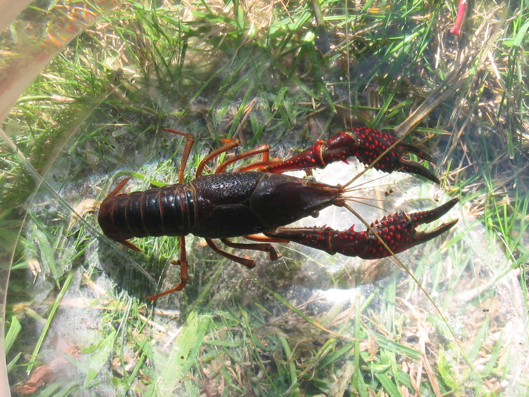Faculty and Students Uncover Link Between Invasive Species and Disease in Southern California
 In a new study published in Conservation Biology, researchers from Pepperdine University, the US Geological Survey, and University
of California, Los Angeles, along with collaborators at the Las Virgenes Municipal
Water District and Mountains Restoration Trust, investigated the effect that invasive
red swamp crayfish (Procambarus clarkii) have on native, juvenile dragonflies and mosquito larvae within the Santa Monica
Mountains National Recreation Area.
In a new study published in Conservation Biology, researchers from Pepperdine University, the US Geological Survey, and University
of California, Los Angeles, along with collaborators at the Las Virgenes Municipal
Water District and Mountains Restoration Trust, investigated the effect that invasive
red swamp crayfish (Procambarus clarkii) have on native, juvenile dragonflies and mosquito larvae within the Santa Monica
Mountains National Recreation Area.
Since its introduction to California in the early 1900s, the red swamp crayfish native to the southern and southeastern United States has invaded streams and displaced top predators in aquatic ecosystems. Within local streams and pools, juvenile dragonflies, or dragonfly “nymphs,” typically play a key role in consuming mosquito larvae and reducing their numbers. The study ties the presence of invasive crayfish to higher numbers of mosquito larvae within the Santa Monica Mountains.
Gary Bucciarelli, adjunct biology professor at Pepperdine and the paper’s lead author, explains that understanding the ways in which non-native species are introduced into a system and the ways in which their presence compromises the ecosystems of native species shed light on the importance of healthy ecosystems and their role in public health and disease control.
"The general public is deluged with information from the media about the importance of native species and protecting environments and restoring natural ecosystems,” Bucciarelli says. “This is a very clear example of how the dimensions of human diseases and natural healthy ecosystems directly impact the public’s well-being.
The research outcomes indicate that the presence of the red swamp crayfish could be particularly problematic in urbanized streams with slow-moving or still water, where mosquitoes thrive. Lee Kats, vice provost for research and strategic initiatives and professor of biology at Pepperdine, has studied these particular streams for decades and led the lab and field experiments that uncovered the staggering results.
The Pepperdine team, comprised of Kats, Bucciarelli, and two former Seaver College students, Avery Davis (’16) and Dan Suh (’16), discovered an abundance of mosquito larvae and few dragonfly nymphs in the streams inhabited by crayfish. However, in streams not inhabited by crayfish, the team found no traces of mosquito larvae and more evidence of dragonfly nymphs. The loss of the dragonfly nymphs, they discovered, was directly linked to the crayfish that had decimated local native species population sizes. An increase in mosquito larvae, due to the absence of native predators that feed on them, leads to the increase in mosquitoes, which poses a greater risk to human health.
The scientists led field surveys and collected crayfish and dragonfly nymphs, bringing them into the laboratory to test whether crayfish affected nymph and mosquito larvae abundance, and dragonfly nymphs’ efficiency as predators. In addition, field crews spent months in the Santa Monica Mountains, carefully recording abundances of dragonfly nymphs and mosquito larvae in streams with and without the red swamp crayfish. Back in the laboratory, other researchers watched as crayfish and dragonfly nymphs hunted mosquito larvae separately and together.
On average, dragonfly nymphs in the lab consumed 70 percent of all mosquito larvae within the first hour. When crayfish were the primary predator, or when dragonfly nymphs and crayfish were placed in the same tank, they consumed only 12 and 7 percent of mosquito larvae in the same time period. Within two days, the crayfish had consumed the dragonfly nymphs themselves.
“Sometimes people are not overly concerned about invasive species,” says Kats. “But this study nicely illustrates that disruptions produced by invasive crayfish have the potential to come back and negatively impact human health.”
Crayfish photo: US Geological Survey